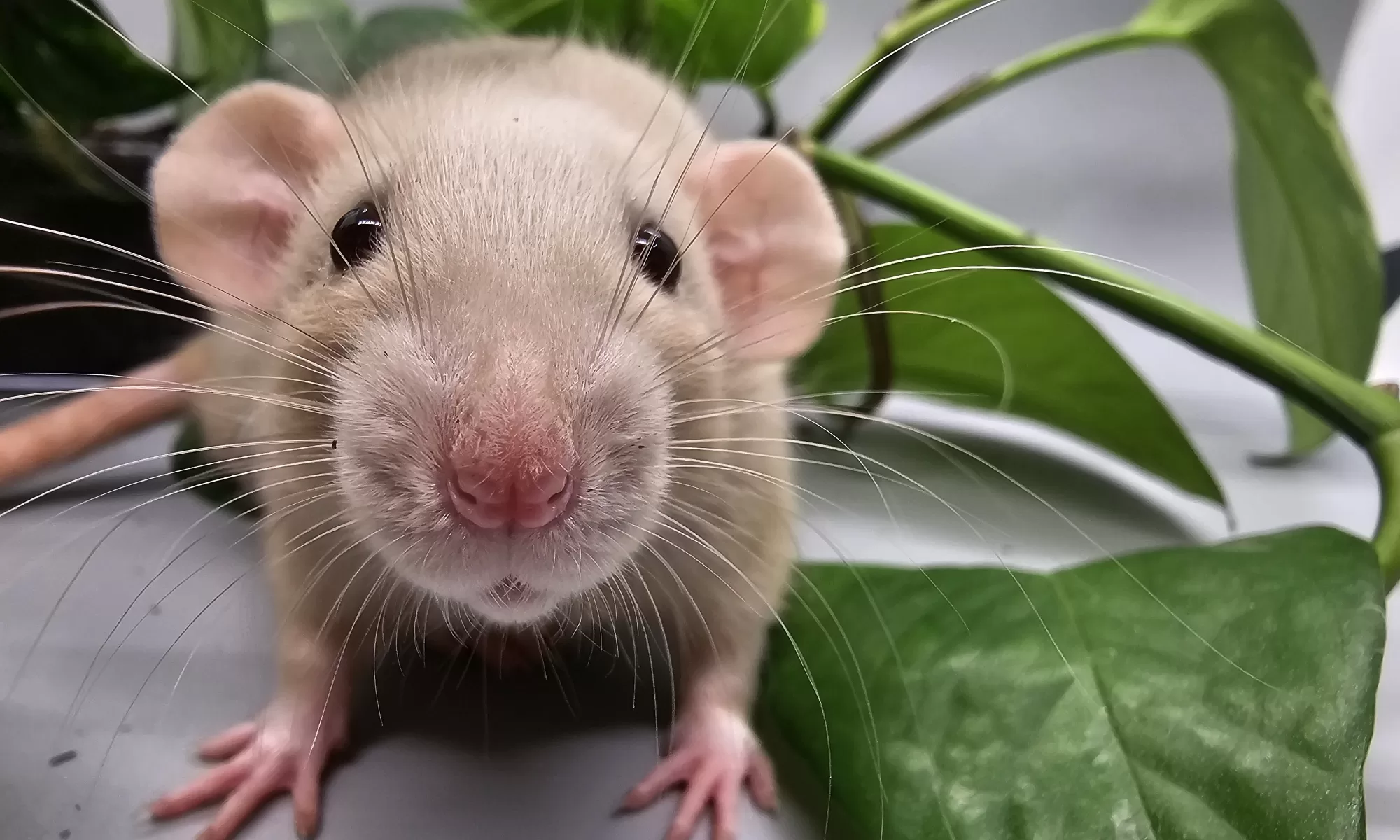Introductions
Arguably one of the most stressful times for both rat and owner, introductions are often one of the most asked about aspect of rat ownership. And one of the most murky.
A lot of variables go into a successful introduction – age, sex, history, existing temperament, health, reproductive status, method of introductions, and even the current dynamics of the introductory mischief. How do these variables play into a successful introduction?
An introduction should only take place after a proper quarantine has been followed.
It’s well known that introducing babies to babies is the easiest age. It’s also often suggested to introduce babies as pairs to an existing, older mischief. The reasoning behind this is two-fold:
1. As babies, they lack the adult level of hormones. While less important in does, in bucks this means that testosterone is still at a low enough level that you’re less likely to experience intact “buckish” behaviors.
2. Babies are hyperactive and want to play. Older rats do not necessarily want to be bothered, so introing a pair of babies ensures that they have a same-sex playmate. This also helps down the line when your older rats begin to pass away.
In the same vein as point 1 in Age, bucks tend to be far more difficult to introduce newcomers. The ease of this varies a lot due to quality of breeding. A well-bred rat, regardless of sex, should openly accept newcomers with nothing more than normal hierarchy scuffling.
In many cases, the introduction of a newcomer can trigger hormonal aggression in lesser quality bred animals, and you’ll suddenly see rising levels of aggression among the cage. The only potential fix for HA is a neuter.
Does tend to be far more accepting, and thus more flexible. However, HA does exist in does outside the normally acceptable maternal aggression, or MA. In does, HA presents as a general bully-like behavior. Excessive force grooming, chasing off cage mates, heavy vocalizations, and even an increase in negative behaviors during heat cycles. Unlike bucks, a spay does not tend to be as effective, since the uterus and ovaries only produce roughly 25% of a doe’s overall testosterone.
The animal’s upbringing and breeding will make a huge difference in how they accept newcomers. A rat who has been kept solo may have greater issues accepting new rats due to the psychological issues that can be a side effect of being kept alone. Slow introductions may work in this situation, but it’s not a guarantee.
Remember, keeping a solo rat is unethical. They’re highly social animals by nature, and a rat who is aggressive to other rats to the point of needing to be solo is not a stable rat. The negative effects of being isolated are still occurring, and you’re risking the animal to become more aggressive, ill more often, suffer from depression, self-mutilate, and even have a shorter lifespan. The only time when it’s acceptable to keep a solo rat is when you have a geriatric rat who has lost a cage mate, and likely has very few months left themselves. In this instance, excessive human interaction can help mitigate the negative effects, but it doesn’t fully eliminate them.
The existing temperament of an animal will play a huge part in how they accept newcomers. A well-bred rat is far more likely to accept new members of the mischief, but poorly bred rats such as pet store rats, some feeder bred rats, or often rats adopted from shelters tend to have a poorer overall temperament. In cases like this, intros tend to be drawn out, and occasionally completely impossible.
A nervy or shy rat, or, on the other end of the spectrum, a bully, will be more likely to cause issues than a well-bred, confident rat.
This should be pretty straightforward. A sick or chronically ill animal is going to have a much lower threshold for new rats. In many cases, it may not be worth the stress put on the sick or injured animal, and other avenues need to be explored.
An intact animal is more likely to face issues with introductions, but it’s also common for neutered males to be picked on by intact males. This is why purchasing rats from an ethical breeder is so important.
There are a few different types of introductions, and their popularity tends to be regional. If a rat is willing to attack another rat severely, either maiming, intending to kill, or actually killing the other rat, they are genetically and temperamentally unstable, and you’re unlikely to have a positive outcome with any introduction method.
A neutral ground intro is when you take the existing colony and the newcomers and have them meet in a space that isn’t claimed by either. This can be a bed, couch, bathtub, etc. This method can be easily repeated as often as needed and for extended periods of time. A popular space when doing a neutral ground intro is a bed, couch, or playpen that has toys, blankets, and other items to occupy their attention as well as allowing you to sit in the middle of them and have all of them interact with you.
This method is a go-to method for a reason: it works, and it’s safe for everyone involved. If a scuffle were to break out, you’re within close distance and already have tools (that isn’t your hand/arm) that could be used to break up a fight.
For this method, you simply switch the cages for short periods of time to introduce the different scents before the official meeting. This can be repeated multiple times a day over the course of a few days. The goal is to desensitize them to the smell of the other rats before officially meeting face to face.
This method is the opposite of the cage swap and relies on obliterating scents. A deep cage clean is necessary, including washing/throwing away cage items that could soak in scents. The cage should be thoroughly and completely scrubbed down. Once this has been completed, all rats should be given quick baths with animal-safe soap and towel-dried. (While not good to do frequently, bathing a rat once for intros or to help them clean themselves when they can’t is perfectly fine. A sink or a few inches of lukewarm water is best with a platform for them to sit on. A towel is a good option because it provides purchase even when wet.) Once bathed, a drop of pure vanilla extract can be placed between their shoulder blades and they’re placed back into the fresh, clean cage.
This method relies on distraction and utilizes grooming as a bonding activity.
Now, you’re probably asking, “What about the carrier method?” And the answer is simple: Bleuming Tails does not support the use of the carrier method.
The carrier method is based on the psychological idea known as flooding*. Flooding is when an animal or person is over-exposed to stressful stimuli in an attempt to desensitize them to that stimuli. For rats and the carrier method, it’s essentially trauma bonding. Some claim that the “calming down” that occurs during the carrier method is a hierarchy being safely established, but others say that the animals are actually shutting down due to the extreme stress and “pulling into themselves.” Shutting down is a common behavior seen in animals when stress levels become too high, and they can’t escape the stressor. (Some sources suggest taking the rats on a car ride during the carrier method if they aren’t settling down, adding even more stress to the situation.)
The absence of aggression does not immediately translate to the animal being calm.
Rats are prey animals and react to negative stimuli in one of three ways: fight, flight, or freeze. In most instances, a rat will nearly always choose flight if able. The carrier method takes away this option, leaving freeze or fight. For most rats, freeze is going to be their next choice. However, for truly aggressive rats, you’re now pushing their stress levels to the brink where fight may be their choice, and you’ve shoved them into a carrier that is too small to effectively and safely break up the fight.
*Flooding is a valuable training technique when used correctly, but the pros and cons of any method should always be weighed for the best interest of the animal, and ideally performed by an animal professional.
While it seems smart in theory, placing cages closely to each other is actually a recipe for disaster. It often just builds barrier aggression and stress, which is the opposite of what we want.
The biggest perk of a well-bred rat is the speed with which intros can be completed. However, in rats who aren’t well-bred, rushing intros can have the opposite effect and increase issues. Some intros could take days of work, potentially weeks, but remember that a truly aggressive rat is not going to change without medical intervention.
Aggression cannot be hugged away.
We’ve all heard the phrase “no blood, no foul” as a means to gauge whether a level of aggression is okay. In general, any extended behaviors you see that fall under active aggression is a hard “no.” You should keep a close eye on any rat who displays passive aggression signs.
In general, a normal introduction will see mild chasing, some force grooming, mild boxing that is easily broken up, and some vocalizations.
Unfortunately, in the rat world, most rat noises can either be positive or negative and must also be combined with other physical signs in order to understand the situation.
1. A medium length, loud, high-pitched squeak
This type of squeak generally indicates being startled or mildly annoyed.
2. An extremely long high-pitched squeak resembling a scream
This noise requires an immediate check on the mischief. This definitely indicates that something is wrong.
3. A lower-pitched, whine-type of squeak
This is the type of squeak you hear when a rat is annoyed, like when food is being stolen or when being power groomed.
4. A quick, lower-pitched squeak
You’ll hear this type of squeak when they are seriously annoyed. It’s commonly heard when you’re handling a rat that doesn’t want to be handled. When temperament testing, too much of this squeak is undesirable.
5. Teeth chattering or “chittering”
This is one of the noises that can be either very good or very bad. Chittering can mean a high level of stress, but it can also mean it’s a happy rat.
6. Hissing
Yes, rats hiss. A hiss is never good. It’s generally a warning that they are about to attack.
Bruxing: This sounds like a grinding noise and is caused by rats grinding their back teeth together. (This is actually how rats naturally keep their own teeth at a correct length.) Bruxing can be good or bad, just like chittering.
Peeping: Short, soft little peeping noises, usually heard when being mutually groomed.
This post covers what can be considered passive aggression, or warnings that will likely precede attacks and more active aggression. These are your warning signs.
1. Puffed Hair
Rats will puff their hair either when they are feeling insecure or in pain. It is also a sign of back off.
2. Freezing
A rat that freezes is a scared, unsure rat. They’re frightened.
3. A slapping tail
Some rats wag their tails, and that’s generally a positive sign of happiness. A rat who is smacking their tail in an agitated manner is telling something to back off.
4. Bearing teeth
A rat who is bearing their teeth is a rat that is at the breaking point.
5. Arched back
A rat will often arch their back, similar to a cat does when angry. It’s a method of making themselves larger to their opponent.
1. Phantom Bites
This is when a rat will lunge at a target and snap in the air. They generally do not make contact with these snaps, and instead, use them as a warning.
2. Shoving
Just like with people, rats will shove other rats. They do this when they are being severely bothered and are annoyed.
3. Crawling over/under or Rolling Over
Rats do the former when it comes to displaying dominance. Rolling over onto their back protects their hindquarters and the back of their neck, which are the most common targets in rat fights. It also allows them to use all 4 legs in defense.
4. Sizing up
This is when 2 rats will face each other and often crab walk around each other, never turning their backs. This is usually the first step toward boxing or fighting.
5. Sidleing
Similar to sizing up, except, instead of just a staredown, they will arch their backs and push up against their opponent.
6. Boxing
This is when both rats stand on their hind legs and use their forelimbs in a “boxing” manner.
7. Kicking
Many rats will sidle up to another rat and kick out with their back legs.
8. Wrestling/pinning/force grooming
Rats will wrestle and pin each other during dominance fights. Power grooming, or force grooming, is another way to show dominance. Can be seen during play.
9. Mock humping
Males will hump males and females will hump females. It doesn’t have anything to do with mating and everything to do with dominance.
10. Fighting
It’s very easy to distinguish true fighting from boxing/wrestling or play. Never try to break up a rat fight using your hand. You will get bit. Fighting rats can result in severe wounds or even death of one or both rats. A fight is the end result of all/some of the other behaviors detailed in these posts.
Fighting is generally loud and results in a lot of running, screaming, shrieking, and general ruckus.
YOU MAY LIKE:



